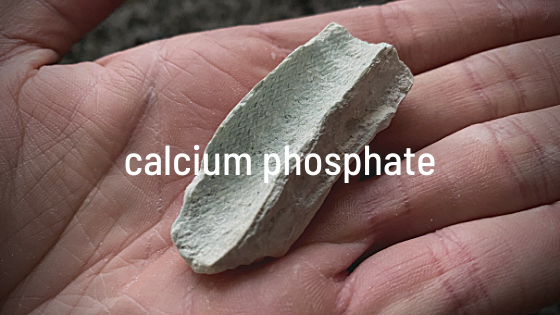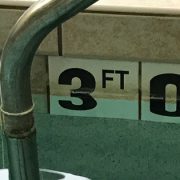Calcium Phosphate Scale
Unless it has happened to you, it is tough to comprehend how severe of a problem calcium phosphate scale can be. Calcium phosphate is no ordinary scale (calcium carbonate); it is both physically harder, and harder to remove when it forms. On the Moh’s 1-10 scale of mineral hardness, normal calcium carbonate (calcite) is a 3, and calcium phosphate is a 5. In this artcile, we discuss what calcium phosphate is, how it forms, and the problems it can cause for swimming pools.
What is Calcium Phosphate?
Calcium phosphate is a mineral formation, also called apatite, made up of Calcium (Ca), Phosphorus (P), and Oxygen (O). Some variations include Hydrogen (H) and other elements too. Calcium phosphate’s formula looks like (Ca5(PO4)3). Again, there are variations:
- Apatite Ca5(PO4)3
- Hydroxyapatite – Ca10(PO4)6(OH)2
- Fluorapatite – Ca5(PO4)3F
- Chlorapatite – Ca5(PO4)3Cl
Some of these minerals are natural in the human body, such as hydroyapatite (aka hydroxylapatite), which is the primary component of tooth enamel. Calcium phosphate, in one form or another, is the primary component of animal bone. That said, it remains somewhat of a mystery as to why some pools get this subtance forming hardened scale deposits, while most pools never do. So what creates calcium phoshate in swimming pools?
Calcium Phosphate Formation in Water and Filters
Before going into this, please keep in mind we are not experts on this topic. We are still learning, and trying to distill the research online and explain it to our readers. There is no shortage of research on calcium phosphate in biology, but almost none for swimming pools. The main question we have is why does calcium phosphate form in water? What are the ingredients needed? What is the catalyst for the reaction? What factors contribute into the “perfect storm” that allows for this brutally resilient form of scale to form?
Well, for that, we started with a wikipedia search, and found this. The article explains, in depth, how calcium phosphate can be synthesized artificially. Since a swimming pool is not exactly a natural environment, we figured this might help us get closer to what’s going on than looking at how calcium phosphate forms in nature. One of the methods to pull these nanocrystals out of suspension is called wet chemical precipitation. The reaction looks like this:
10 Ca(OH)2 + 6 H3PO4 → Ca10(PO4)6(OH)2 + 18 H2O
Calcium Hydroxide + Phosphoric Acid yields Hydroxlapatite + Water
IF this is a representation of what could be happening in swimming pools, there are a few things of note. First, phosphoric acid (or phosphonic acid) is a common pool chemical used for sequestering metals and inhibiting scale. If a calcium phosphate problem is occuring–but is mistaken for carbonate scale–perhaps pool operators are adding fuel to the problem when they apply a phosphate-based sequestering agent. We know phosphates can be introduced to water many different ways, and phosphonic acid sequests are a very common one.
Secondly, calcium hydroxide is the most soluble form of calcium in a cement-based plaster pool finish. If the water is aggressive on the LSI or Ryznar index, calcium hydroxide can be extracted from the surface and pulled into solution by the water. Could this be part of the problem? Assuming the pH is low enough and this calcium does not get immediately carbonated, it stands to reason that calcium hydroxide could indeed have enough time to bind to these phosphate-based sequestering agents.
Calcium and Phosphate normally do not bind. What changed?
This is the million dollar question. Phosphates and calcium typically do not bind. Even pools with high phosphate issues rarely have a problem with calcium phosphate scale. The vast majority of commercial pools on calcium hypochlorite (cal hypo) chlorine never have these problems either. The rarity is what draws all this into question. If it were as easy as saying “aggressive water + phosphate-based sequestering agents cause calcium phosphate”, that would be lovely. We are just not convinced that’s the entire story. We still think there’s something else going on.
One idea in the industry is heat. Heat may drive the reaction, much like it helps drive calcium carbonate scale out of solution. Here’s a great article and case study of a pool with a calcium phosphate problem. The article mentions that calcium phosphate does not precipitate the same way calcium carbonate does. A high pH does not drive the reaction for calcium phosphate. In fact, it may just be the opposite if we are talking about calcium hydroxide.
So back to the question…what changed? It appears that it’s not just calcium (Ca) and Phosphates (O4P-3) involved, but different forms of them. Rather than calcium, it looks like it could be calcium hydroxide, and it may not be an orthophosphate, but a polyphosphate or phosphoric acid. Even without knowing all the details of how this reaction takes place, we know from empirical evidence that it does, in fact, happen. So let’s talk about how to remedy the problem.
How to remove calcium phosphate scale from swimming pool filters
 Unfortunately, calcium phosphate scale a stubborn substance that usually needs to be physically removed. This could mean grinding it off the surface, chiselling, or literally taking a pneumatic jackhammer to it. If you have a sand filter, calcium phosphate can bind sand together so densely that it seems as hard as concrete.
Unfortunately, calcium phosphate scale a stubborn substance that usually needs to be physically removed. This could mean grinding it off the surface, chiselling, or literally taking a pneumatic jackhammer to it. If you have a sand filter, calcium phosphate can bind sand together so densely that it seems as hard as concrete.
This creates obvious problems for filtration, but also costs pool owners dearly. We have no good chemical solution for breaking down calcium phosphate scale, and acid seems to do very little to it. Prevention, then, is the best method.
Preventing Calcium Phosphate Scale
In one sentence: keep phosphate levels to a minimum, and keep your water balanced.
According to renown water chemist Richard Falk, a good threshold to stay below is 500 parts-per-billion of phosphates. Normally it takes far more than 500 ppb for calcium phosphate to occur, but as a matter of best practice, keeping phosphate levels as low as possible virtually removes this variable. Without high phosphates, the likelihood of calcium phosphate shrinks.
In that same vein, avoid using chemicals that contain phosphates. This obviously applies to the phosphoric acid sequestering agents we mentioned earlier, but also for any other products that may contain phosphate. Some cleaning solutions may contain phosphate, for example. Keep them away from your pool.
Balance your pool according to either the LSI, or Ryznar Index. We have a free app you can download called “LSI Calculator”. The app has a dosing calculator and shows you a real-time view of your water balance. Keep your water properly balanced, and the risk of calcium phosphate problems is further reduced.
NextGeneration can help
We also have two products in our line that can help prevent this issue. First, our Concentrated Phosphate Remover, CPR, removes phosphates of any kind (not just orthophosphates that you can measure). Using CPR with decent regularity is a simple way to stay ahead of this problem.
As a replacement for a sequestering agent, consider our Metal and Scale Inhibitor, MSI. MSI contains no phosphates, and is totally compatible with our phosphate remover and enzymes. Both MSI and CPR, like all of our product line, are NSF/ANSI Standard 50 Certified, which means they are certified as safe for use in commercial swimming pools.
In summary, calcium phosphate is a real thing, and while rare, it can be very costly to correct. Prevention is the best strategy.




